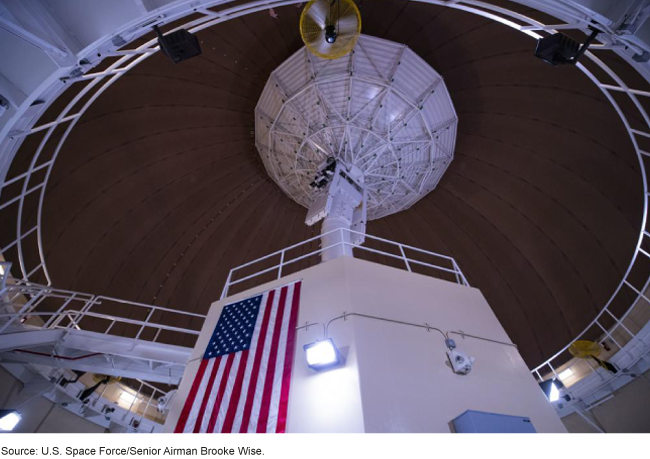Satellite Control Network: Updating Sustainment Plan Would Help Space Force Better Manage Future Efforts
Fast Facts
Space Force—a branch of the U.S. military—runs a network of 19 antennas around the world that communicate with and control U.S. government satellites. This network is aging and difficult to maintain. At the same time, demand on the network is increasing as more satellites are launched.
Space Force's long-term plan to sustain this network hasn't been updated since 2017, so it doesn't reflect recent acquisitions or organizational changes. For instance, it's unclear which staff offices within Space Force are responsible for maintaining this network.
We recommended that Space Force update this plan to effectively plan and budget its efforts.
A radar antenna receives data from satellites at Kaena Point Space Force Station, Hawaii.

Highlights
What GAO Found
The Satellite Control Network (SCN) is a system of 19 globally distributed antennas that supports launch and day-to-day control of U.S. government satellites, including defense and intelligence satellites. The U.S. Space Force is responsible for managing, sustaining and upgrading the network.
User demand for SCN support runs high and is expected to increase. The utilization rate for the SCN has averaged 75 percent over the last decade. This rate exceeds the 70 percent level that Space Force officials cite as the threshold the commercial industry uses to indicate the need for more capacity. Annual SCN-supported satellite launches have also tripled since 2012. Satellite users who rely on the SCN and whom GAO interviewed said that this increased demand, and resulting limits on system availability, could compromise their missions in the future.
Satellite Control Network's Average Utilization Rate from Fiscal Year 2012 to 2021

Space Force is developing approaches to address SCN demand and other challenges, but Space Force lacks an updated long-term sustainment plan. For example, it has requested SCN users to reduce-non critical contacts. This step has helped reduce utilization rates in recent years. Space Force is also managing two improvement efforts to update ground control electronics and antennas intended to sustain the SCN. However, the SCN lifecycle sustainment plan, issued in 2017, does not include these efforts or reflect the transition of SCN's responsibility to Space Force. Updating or issuing a new plan would help Space Force better plan for future SCN sustainment.
Space Force is seeking additional SCN capacity by exploring the use of commercial antennas and those operated by other federal agencies. Both could provide some capacity to SCN-supported satellites. Space Force is also working to develop and acquire 12 new, higher-capacity antennas, an effort known as Satellite Communication Augmentation Resource. The first prototype is expected in 2025.
Why GAO Did This Study
Space Force's SCN provides critical launch and operations support for satellites worth billions of dollars with a broad range of missions. The SCN makes over 450 daily contacts with satellites. The network is facing sustainment and obsolescence issues while demands on the system are increasing.
A Senate report included a provision for GAO to review the SCN program. This report assesses Space Force's (1) current and future needs for the SCN; (2) efforts to address challenges in sustaining the SCN; and (3) acquisition efforts to support SCN needs.
To conduct this work, GAO analyzed SCN utilization and launch data; and reviewed Department of Defense, Space Force, and Air Force reports and briefings, SCN sustainment documents and data, and contracting and acquisition documents. GAO used a non-generalizable sample to select four SCN users from different federal agencies and interviewed representative officials. GAO also interviewed Space Force agency and SCN program officials.
Recommendations
GAO recommends that Space Force update the SCN lifecycle sustainment plan, or issue a new one, that includes current efforts and Space Force responsibilities. DOD agreed with this recommendation.
Recommendations for Executive Action
| Agency Affected | Recommendation | Status |
|---|---|---|
| Department of the Air Force | The Secretary of the Air Force should ensure that Space Systems Command updates or issues a new lifecycle sustainment plan that includes information about all the current sustainment strategies, related programs, the updated Space Force organizational structure, and other relevant information for the Satellite Control Network. (Recommendation 1) |
The Air Force concurred with this recommendation. In August 2023, Space Force's Space System Command approved an updated life-cycle sustainment plan for the Satellite Control Network. In November 2023, the Department of Defense provided GAO with a copy of the plan. We assessed the plan and found that it that reflects all the current sustainment strategies, related programs, and recent organizational changes in keeping with our recommendation.
|
